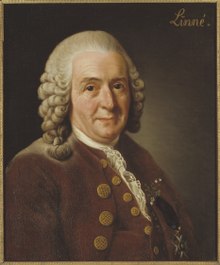Carl Linnaeus | |
|---|---|
 Portrait by Alexander Roslin, 1775 | |
| Born | 23 May 1707[note 1] |
| Died | 10 January 1778 (aged 70) Hammarby, Sweden |
| Resting place | Uppsala Cathedral 59°51′29″N 17°38′00″E / 59.85806°N 17.63333°E |
| Alma mater | |
| Known for | |
| Spouse | |
| Children | 7 |
| Awards | ForMemRS (1753) |
| Scientific career | |
| Fields | |
| Institutions | Uppsala University |
| Thesis | Dissertatio medica inauguralis in qua exhibetur hypothesis nova de febrium intermittentium causa (1735) |
| Notable students | |
| Author abbrev. (botany) | L. |
| Author abbrev. (zoology) | Linnaeus |
| Signature | |
Carl Linnaeus[a] (23 May 1707[note 1] – 10 January 1778), also known after ennoblement in 1761 as Carl von Linné,[3][b] was a Swedish biologist and physician who formalised binomial nomenclature, the modern system of naming organisms. He is known as the "father of modern taxonomy".[4] Many of his writings were in Latin; his name is rendered in Latin as Carolus Linnæus and, after his 1761 ennoblement, as Carolus a Linné.
Linnaeus was the son of a curate[5] and was born in Råshult, in the countryside of Småland, southern Sweden. He received most of his higher education at Uppsala University and began giving lectures in botany there in 1730. He lived abroad between 1735 and 1738, where he studied and also published the first edition of his Systema Naturae in the Netherlands. He then returned to Sweden where he became professor of medicine and botany at Uppsala. In the 1740s, he was sent on several journeys through Sweden to find and classify plants and animals. In the 1750s and 1760s, he continued to collect and classify animals, plants, and minerals, while publishing several volumes. By the time of his death in 1778, he was one of the most acclaimed scientists in Europe.
Philosopher Jean-Jacques Rousseau sent him the message: "Tell him I know no greater man on Earth."[6] Johann Wolfgang von Goethe wrote: "With the exception of Shakespeare and Spinoza, I know no one among the no longer living who has influenced me more strongly."[6] Swedish author August Strindberg wrote: "Linnaeus was in reality a poet who happened to become a naturalist."[7] Linnaeus has been called Princeps botanicorum (Prince of Botanists) and "The Pliny of the North".[8] He is also considered one of the founders of modern ecology.[9]
In botany, the abbreviation L. is used to indicate Linnaeus as the authority for a species' name.[10] In zoology, the abbreviation Linnaeus is generally used; the abbreviations L., Linnæus and Linné are also used.[c] In older publications, the abbreviation "Linn." is found. Linnaeus's remains constitute the type specimen for the species Homo sapiens[11] following the International Code of Zoological Nomenclature, since the sole specimen that he is known to have examined was himself.[note 2]
Cite error: There are <ref group=note> tags on this page, but the references will not show without a {{reflist|group=note}} template (see the help page).
- ^ "Linnaeus". CollinsDictionary.com. HarperCollins.
- ^ "Linnaeus, Carolus" in the Oxford Dictionaries Online.
- ^ Blunt (2004), p. 171.
- ^ Calisher, CH (2007). "Taxonomy: what's in a name? Doesn't a rose by any other name smell as sweet?". Croatian Medical Journal. 48 (2): 268–270. PMC 2080517. PMID 17436393.
- ^ "Carolus Linnaeus | Biography, Education, Classification System, & Facts". Encyclopædia Britannica. Archived from the original on 28 March 2023. Retrieved 12 April 2023.
- ^ a b "What people have said about Linnaeus". Linné on line. Uppsala University. Archived from the original on 8 June 2011. Retrieved 3 October 2011.
- ^ "Linnaeus deceased". Linné on line. Uppsala University. Archived from the original on 7 February 2021. Retrieved 3 October 2011.
- ^ Broberg (2006), p. 7.
- ^ Egerton, Frank N. (2007). "A History of the Ecological Sciences, Part 23: Linnaeus and the Economy of Nature". Bulletin of the Ecological Society of America. 88 (1): 72–88. doi:10.1890/0012-9623(2007)88[72:AHOTES]2.0.CO;2.
- ^ "Linnaeus, Carl (1707–1778)". Author Details. International Plant Names Index. Archived from the original on 14 May 2019. Retrieved 1 October 2011.
- ^ "Type Specimens: An Overview". American Museum of Natural History. 26 February 2015. Retrieved 25 April 2024.
Cite error: There are <ref group=lower-alpha> tags or {{efn}} templates on this page, but the references will not show without a {{reflist|group=lower-alpha}} template or {{notelist}} template (see the help page).